Ceviche with Ají Amarillo

Making ceviche at home can be very intimidating to a lot of people. Luckily, if you follow a few basic guidelines, the process is quite simple and can yield very impressive results. This version is made with Ají Amarillo, which lends the ceviche it’s incredible flavor and striking color.
Choosing fish for ceviche
The most important aspect of making good ceviche is using very fresh fish. Look for saltwater fish with firm, white flesh. Flounder, snapper, and black/striped bass are good choices. I prefer to buy whole fish and butcher them at home so that I can inspect the fish for myself. If you don’t feel comfortable judging the freshness of fish on your own, have a conversation with your fishmonger. Explain to them that you are planning to make ceviche (eating raw fish!) and that you need to use the freshest fish possible. Getting people sick is bad business and most reputable fishmongers will be upfront about what you should/shouldn’t eat raw. Remember, the fish you use for ceviche should not smell fishy at all. If it does, you are better off using it in a cooked application.
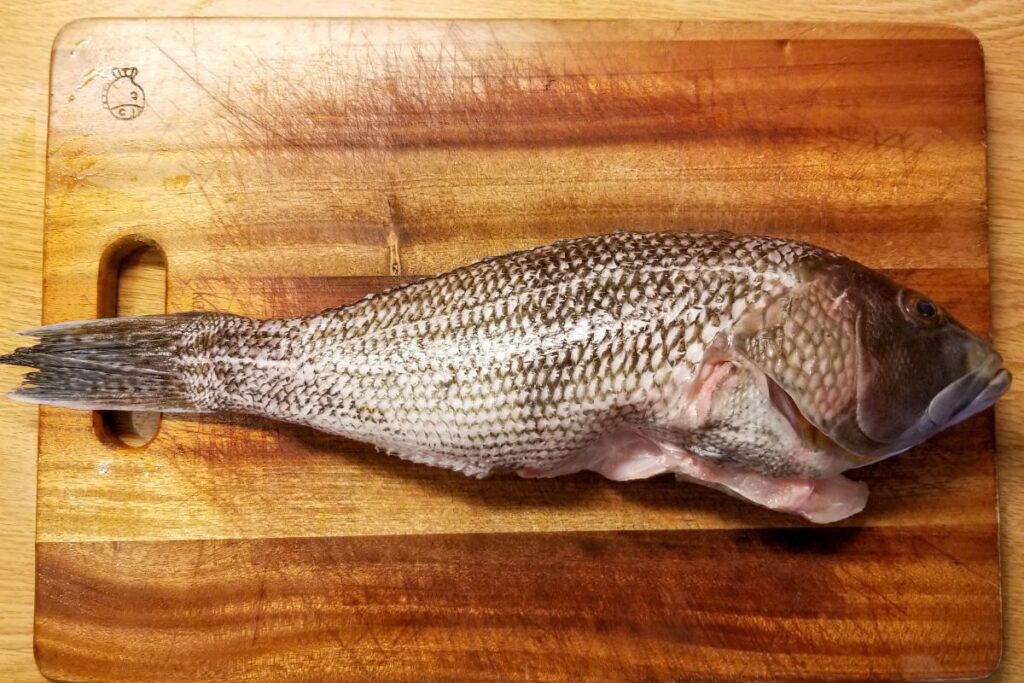
Leche de Tigre
The second most important aspect of a good ceviche is the “leche de tigre” AKA tiger’s milk. A good Peruvian-style leche de tigre should be bracingly sour, salty and delicious all on its own. Many Peruvian restaurants serve leche de tigre in shot glasses without any diced fish!
Ají Amarillo
Ají Amarillo is one of the foundational peppers of Peruvian cuisine. Unfortunately, fresh Ají Amarillo peppers are almost impossible to find here in the US. Many cooks will often use a jarred pepper paste in their recipes, which I have never been fond of. Luckily, frozen (whole) Ají Amarillo peppers can be purchased from many Latin-American markets. Because the peppers are being cooked and blended, the difference between fresh and frozen peppers in the finished dish is minimal. Just make sure the peppers still look vibrant and haven’t been freezer-burned. If you can’t find Ají Amarillo, this leche de tigre would be delicious with almost any medium-spicy pepper, even jalapenos.
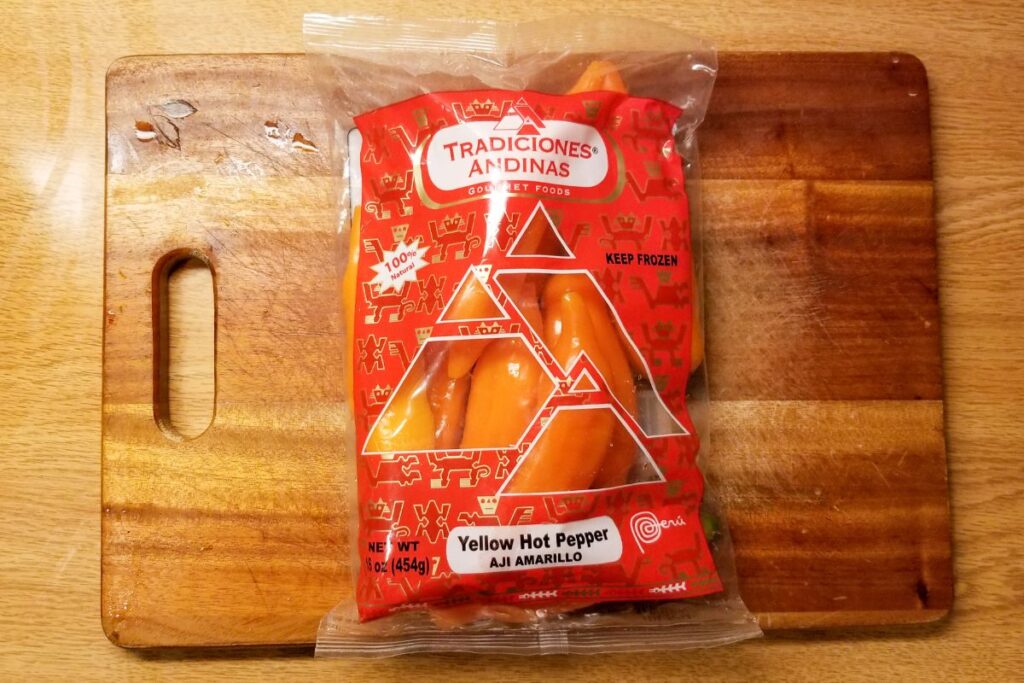
Keep it cold and serve immediately
For some reason, many people believe that ceviche should be marinated and “cooked” for a while in the acidic dressing before serving. This is absolutely incorrect. A good ceviche is served right after it has been mixed. If you allow the fish to sit in the leche de tigre for any longer than a few minutes, the fish will begin to get grainy and mushy.
Make sure to keep everything as cold as possible throughout the entire process of prepping and serving the ceviche. A good ceviche should be fresh, cold, bright, and acidic. A cold mixing bowl and serving bowl/plate are essential
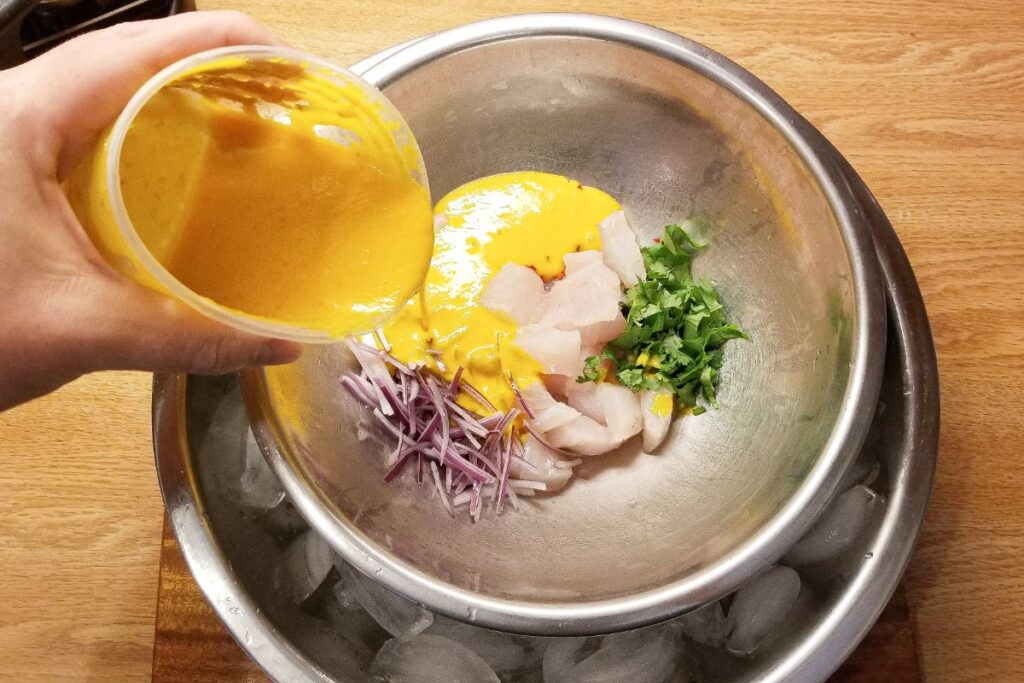
Round Out Your Peruvian-ish Dinner With:
- Anticuchos – Peruvian Grilled Beef Heart Skewers
- Crispy Yucca Fries with Yuzukosho Aioli
- Fried Sweet Plantains
- Fried Green Plantains with Jalapeno-Cilantro Sauce (almost the same sauce as in this recipe)
- Fluke Ceviche with Coconut Milk, Corn, and Tomatoes
- Lomo Saltado

Ceviche with Ají Amarillo
Ingredients
Ceviche
- 300-400 grams very fresh, firm, white-fleshed fish fillet such as black bass, striped bass, flounder, or snapper. Kept very cold. (3/4#)
- 25 grams thinly julienned red onion
- 5-10 grams minced fresno pepper (or any spicy pepper of your choice)
- 5 grams roughly chopped cilantro
- small drizzle extra virgin olive oil
- 1-2 Tbsp cold water (or as needed)
Ají Amarillo Leche de Tigre
- 100 grams sliced ají amarillo pepper, seeds and stems removed (if using frozen ají amarillo, thaw under running water for a few minutes before slicing, could also use any other medium-heat pepper such as jalapeno)
- 1/2 Tbsp extra virgin olive oil
- 15 grams sliced celery
- 5 grams sliced garlic
- 5 grams washed cilantro stems (no leaves)
- 10 grams sliced shallot or red onion hearts (dont use the dark outer layers of red onion or it will stain the color of the Leche de Tigre)
- 12 grams neutral-flavored cooking oil
- 130 grams lime juice
- 10 grams salt
Instructions
Ají Amarillo Leche de Tigre
- Sautee the sliced peppers in the 1/2 Tbsp olive oil over medium-low heat for 3-4 minutes. Peppers should soften slightly but not get any color.

- Place the softened peppers on a plate and cool in the refrigerator or freezer until no longer warm.

- Measure out the rest of the ingredients and place in blender with the sauteed peppers.
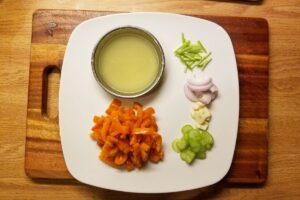
- Blend everything very well but do not allow the blender to run so long that the Leche de Tigre gets warm. Set sauce in the refrigerator until ready to use.

Making the ceviche
- Put your serving plate into the refrigerator or freezer to get very cold.
- Check to make sure fish fillets do not smell fishy in any way. Check for bones and remove them with pliers or tweezers if necessary.

- Cut the fish into roughly 3/4 inch chunks.

- Set a metal or glass bowl into another bowl with ice in it to make sure everything stays very cold. Add the diced fish, sliced onion, minced peppers, and chopped cilantro into the ice-cold bowl.
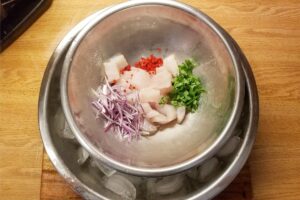
- Add the cold leche de tigre and combine mix everything well.
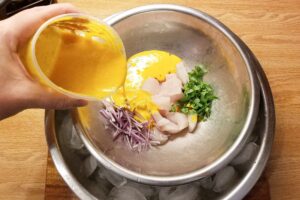
- Leche de tigre should coat the fish nicely while still being loose enough to pool at the bottom of the bowl. If it is too thick, feel free to add 1-2 tablespoons of cold water to get the consistency right. The leche de tigre should take care of almost all the seasoning. If you feel it needs a touch more salt or lime juice, add it now.

- Serve the ceviche immediately after mixing! Do not allow it to marinate and "cook" in the dressing. Place the ceviche on the chilled plate and allow any excess leche de tigre to pool on the bottom of the plate. Finish with a drizzle of olive oil.

Excellent recipe!
Having trouble converting the grams to cups/ounces.
Is there a way to get a proper conversion since grams and cups measure differently?
Super excited to try this recipe!
It looks amazing!
Hi! I hope you get a chance to make it! I intentionally used a scale and measured in grams because many of these ingredients would be hard to measure using volumetric measurements. I considered using cups/ounces for ease of use but I wanted to veer on the side of accuracy so folks don’t have issues with the recipe not turning out right….thank you for your input though! Maybe I will have to consider this more often going forward…
Great recipe, just make sure you tell people that when you started saltee the spicy yellow peppers, all that spice goes into your eyes and your lips and face!! Terrible experience for me!! But I love the results:)
I’m so sorry! You must have had a spicy batch of peppers! So glad you liked the recipe!